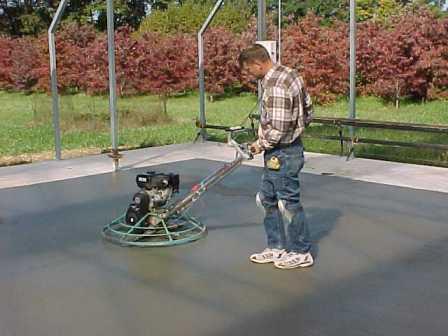Power float
A power float is a hand-operated machine used to produce a smooth, dense and level surface finish to insitu concrete beds. Power floating eliminates the time and materials needed to apply a finishing screed and is quicker and less labour-intensive process than hand trowelling.
Power floats have an electric motor or petrol engine fixed over a circular pan or skimmer which smooths concrete before hardened steel reversible metal blades rotate at up to 150 rpm over the surface to create a hardened finish.
Before power floating the concrete must be left to partially set, having been leveled and tamped. The amount of setting time necessary before power floating will depend on variables such as; air temperature, humidity, the specification of the mix and so on. A rough guide for considering when to begin power floating is when walking on the surface leaves indentations of 3-4 mm. If the concrete is too wet the machine will tear up the surface, and if it is too dry, it will not be possible to trim high spots or fill low spots effectively.
Floating usually starts at one end of the slab and moves to the other. The operator holds the float at waist-height and moves backwards so that the float removes their footprints. The speed should be slow and consistent.
Once the surface has been floated, the blades are angled to suit the concrete and achieve the specified finish. Blade angles of around 5-10 degrees are usual, but these may need to be increased after each pass over the surface.
[edit] Related articles on Designing Buildings Wiki
- Breaker.
- Cement.
- Compressed air plant.
- Concrete.
- Concrete vs. steel.
- Concreting plant.
- Laser screed.
- Screed.
- Tremie.
- Types of floor.
- Types of flooring.
[edit] External references
- Speedcrete - Power floating tips
- ‘Building Construction Handbook’ (6th ed.), CHUDLEY, R., GREENO, R., Butterworth-Heinemann (2007)
Featured articles and news
RTPI leader to become new CIOB Chief Executive Officer
Dr Victoria Hills MRTPI, FICE to take over after Caroline Gumble’s departure.
Social and affordable housing, a long term plan for delivery
The “Delivering a Decade of Renewal for Social and Affordable Housing” strategy sets out future path.
A change to adoptive architecture
Effects of global weather warming on architectural detailing, material choice and human interaction.
The proposed publicly owned and backed subsidiary of Homes England, to facilitate new homes.
How big is the problem and what can we do to mitigate the effects?
Overheating guidance and tools for building designers
A number of cool guides to help with the heat.
The UK's Modern Industrial Strategy: A 10 year plan
Previous consultation criticism, current key elements and general support with some persisting reservations.
Building Safety Regulator reforms
New roles, new staff and a new fast track service pave the way for a single construction regulator.
Architectural Technologist CPDs and Communications
CIAT CPD… and how you can do it!
Cooling centres and cool spaces
Managing extreme heat in cities by directing the public to places for heat stress relief and water sources.
Winter gardens: A brief history and warm variations
Extending the season with glass in different forms and terms.
Restoring Great Yarmouth's Winter Gardens
Transforming one of the least sustainable constructions imaginable.
Construction Skills Mission Board launch sector drive
Newly formed government and industry collaboration set strategy for recruiting an additional 100,000 construction workers a year.
New Architects Code comes into effect in September 2025
ARB Architects Code of Conduct and Practice available with ongoing consultation regarding guidance.
Welsh Skills Body (Medr) launches ambitious plan
The new skills body brings together funding and regulation of tertiary education and research for the devolved nation.
Paul Gandy FCIOB announced as next CIOB President
Former Tilbury Douglas CEO takes helm.
UK Infrastructure: A 10 Year Strategy. In brief with reactions
With the National Infrastructure and Service Transformation Authority (NISTA).























